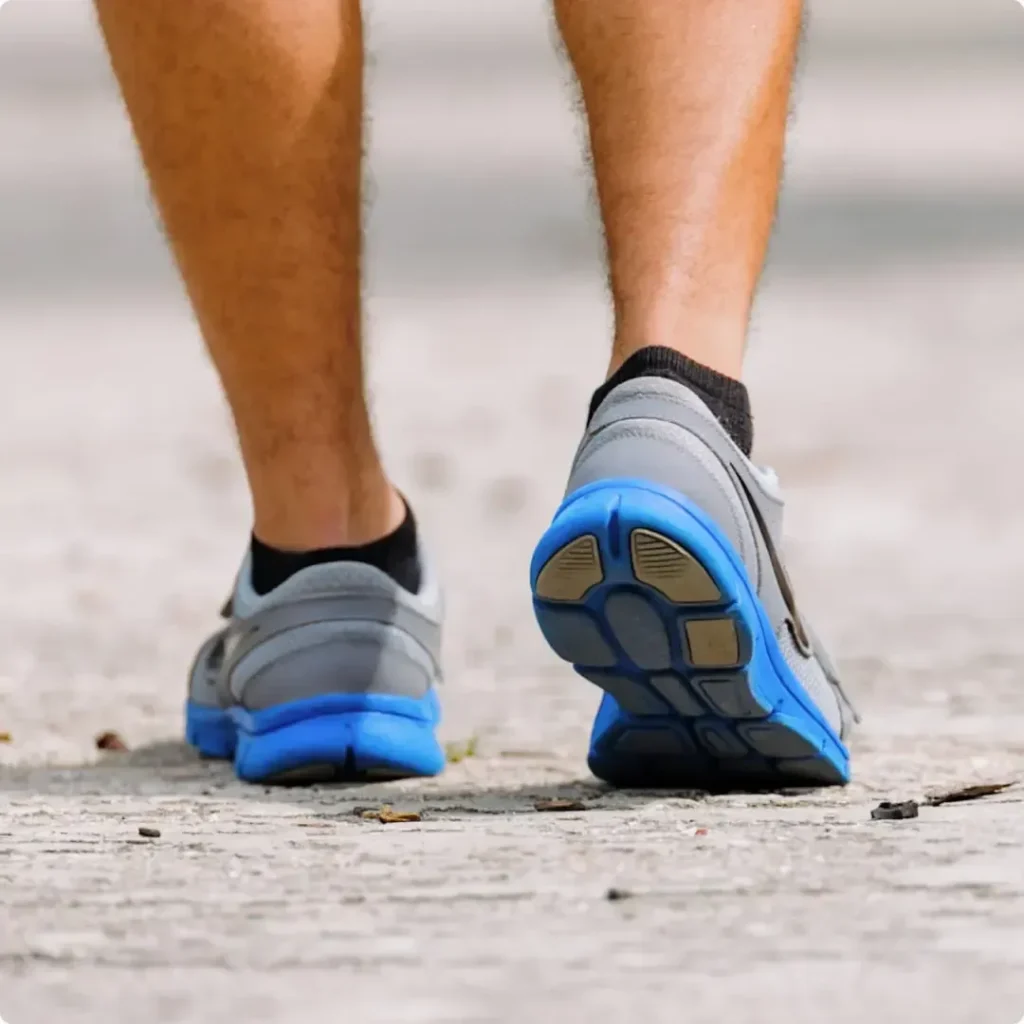
Achilles tendon injuries, commonly referred to as Achilles tendonitis, occur when the Achilles tendon—the strong, fibrous tissue connecting the calf muscles to the heel bone—becomes strained, inflamed, or torn. This injury can range from mild overuse issues to severe ruptures, causing varying degrees of pain and mobility problems. Achilles injuries often result from overuse, sudden trauma, or underlying foot and ankle conditions.
What Causes Achilles Injuries?
Achilles tendon injuries can stem from several factors, with some being preventable and others linked to inherent foot issues. Key causes include:
• Sudden Trauma: A sharp increase in physical activity, particularly high-impact sports like running or jumping, can lead to an Achilles injury.
• Overuse: Repeated stress on the tendon over time, often from continuous training or physical work, leads to micro-tears and eventual injury.
• Poor Stretching and Warm-up Routines: Failing to properly stretch before physical activity can increase the risk of injury.
• Foot Structure Issues: Conditions like flat feet, high arches, or chronic wear of high heels can stress the Achilles tendon, making it more prone to injury.
Symptoms of Achilles Tendon Injury
Achilles injuries often present with noticeable symptoms:
• Pain: Typically located at the back of the ankle, pain may start as a dull ache and increase with movement or exertion.
• Swelling: The tendon may become visibly swollen or feel warm to the touch.
• Limited Mobility: Severe injuries, such as ruptures, may make it difficult to point the toes downward or walk properly.
• “Pop” Sensation: A rupture can be accompanied by a loud snapping sound, followed by immediate pain and weakness.
Types of Achilles Tendon Injuries
Achilles injuries vary in severity:
• Tendonitis: This is an overuse injury causing inflammation and pain. It is common among athletes but can also affect non-athletes.
• Tendonosis: A chronic degenerative condition where the tendon fibers break down.
• Partial Rupture: A small tear in the tendon that affects function but may not cause complete immobility.
• Complete Rupture: The tendon fully tears, causing significant pain and loss of function, requiring immediate medical attention.
Accurate diagnosis of an Achilles tendon injury is crucial for effective treatment and recovery. Diagnosis usually involves a physical examination, imaging tests, and the evaluation of symptoms and medical history.
Physical Examination
During a physical exam, the physician will check for:
• Tenderness and Swelling: The doctor may palpate the tendon to identify inflamed or sensitive areas.
• Range of Motion: You may be asked to flex and extend your foot to assess mobility and detect limitations.
• Thompson Test: This test checks for tendon rupture by squeezing the calf muscles. A lack of foot movement may indicate a torn Achilles tendon.
Imaging Tests
If a rupture or severe injury is suspected, additional diagnostic tests may be needed:
• X-rays: Though X-rays cannot directly show tendon injuries, they help rule out associated fractures or bone issues.
• Ultrasound: This imaging technique visualizes the tendon to detect tears or inflammation.
• MRI: For a more detailed image of the tendon, an MRI can reveal the extent of damage and assist in planning treatment options.
Injury Severity Classification
Achilles injuries can be classified based on their severity:
• Grade 1: Mild strains with minor discomfort and no significant functional limitations.
• Grade 2: Partial tears that cause moderate pain and limit activity.
• Grade 3: Complete ruptures resulting in severe pain, loss of mobility, and the need for immediate medical intervention.
Treatment for Achilles injuries varies depending on the severity of the damage. Options range from conservative, non-surgical methods to surgical interventions for more serious cases.
Conservative Treatments
For mild to moderate injuries, non-surgical treatment is usually effective. This includes:
• Rest and Immobilization: Limiting movement and using crutches, braces, or boots to immobilize the foot and prevent further strain on the tendon.
• Stretching and Physical Therapy: A structured rehabilitation program focusing on flexibility, strength, and balance helps restore tendon function. Stretching exercises are crucial for recovery.
• Medication: Non-steroidal anti-inflammatory drugs (NSAIDs) help manage pain and reduce inflammation.
• Orthotics and Support: Custom foot orthotics or supportive shoes may help redistribute weight and reduce stress on the Achilles tendon during healing.
Physical Therapy
Physical therapy is a key component of recovery, helping patients regain strength and flexibility. Common therapies include:
• Massage Therapy: Manual manipulation to reduce tension in the tendon.
• Cold and Heat Therapy: Alternating cold compresses with heat treatments to manage pain and promote blood flow.
• Ultrasound and Electrical Stimulation: These treatments enhance the healing process by stimulating tissue repair and reducing inflammation.
Surgical Treatment for Severe Injuries
If conservative methods fail or if the tendon is ruptured, surgery may be necessary to repair the damage:
• Tendon Repair Surgery: In cases of rupture, the torn ends of the tendon are surgically stitched back together.
• Tendon Grafting: For more extensive damage, a tendon graft may be used to replace or reinforce the weakened tissue.
• Post-Surgery Recovery: Recovery after surgery involves several weeks of immobilization, followed by physical therapy to restore strength and flexibility.
Achilles tendon injuries can be debilitating, but proper treatment and rehabilitation can lead to full recovery. Preventing future injuries involves making lifestyle adjustments, addressing underlying conditions, and following a structured rehabilitation plan.
Recovery Timeline
The recovery period depends on the severity of the injury and the chosen treatment:
• Non-Surgical Recovery: For mild to moderate injuries, recovery can take several weeks, with patients returning to regular activity in 3-6 months.
• Surgical Recovery: Recovery from surgery may take longer, typically 6-8 weeks of immobilization followed by several months of physical therapy.
Preventing Achilles Injuries
Preventing Achilles tendon injuries involves a proactive approach to foot health and exercise routines:
• Proper Warm-up and Stretching: Always stretch and warm up before engaging in physical activity, focusing on the calf and Achilles tendon.
• Gradual Increase in Activity: Avoid sudden increases in exercise intensity or duration.
• Wearing Supportive Footwear: Use shoes that provide proper support and cushioning, especially during high-impact activities.
• Addressing Foot Issues: Conditions like flat feet or high arches should be managed with custom orthotics to reduce strain on the Achilles tendon.
Returning to Activity
Returning to sports or physical activity should be done cautiously:
• Follow Medical Advice: Stick to your doctor’s or physical therapist’s recommendations regarding when to resume activity.
• Strengthening Exercises: Continue doing strengthening exercises to reinforce the tendon and calf muscles, reducing the risk of re-injury.
Long-Term Care
Achilles tendon injuries may recur if not properly treated. Long-term care focuses on maintaining tendon health:
• Regular Stretching and Strengthening: Make stretching and strength exercises part of your daily routine.
• Footwear Adjustments: Ensure you are always wearing appropriate footwear for your activities to avoid unnecessary strain on the Achilles tendon.
By taking these preventative measures and following a structured recovery plan, you can reduce the risk of future Achilles tendon injuries and maintain optimal foot health.
Stay informed by reviewing some of our patients frequently asked questions about what to expect when visiting one of our Florida or Texas foot and ankle care offices. Contact the office directly if you need further assistance. We’re here to help!
Modern Foot & Ankle offers a wide range of podiatry services including foot and ankle surgery, sports medicine, pediatric foot care, wound care, orthotics, and more. They also provide specialized treatments for conditions such as bunions, hammertoes, heel pain, and ingrown toenails among others.
To schedule an appointment, you can call the clinic directly or fill out the appointment request form available on their website. They have multiple locations, so you can choose the one that’s most convenient for you.
During your first visit, the podiatrist will conduct a thorough examination, discuss your medical history, and address any concerns or symptoms you may have. They will then develop a personalized treatment plan based on your specific needs.
Yes, the podiatrists at Modern Foot & Ankle are skilled in performing a variety of foot and ankle surgeries. These include procedures for bunions, hammertoes, fractures, and more. They utilize the latest techniques and technology to ensure the best possible outcomes for their patients.
Modern Foot & Ankle is committed to providing comprehensive, high-quality podiatric care. They believe in a patient-centered approach, where the focus is on educating patients about their condition and treatment options, enabling them to make informed decisions about their care.
Modern Foot & Ankle accepts a variety of insurance plans. It’s recommended to check with the clinic directly or with your insurance provider to confirm coverage before scheduling an appointment.

